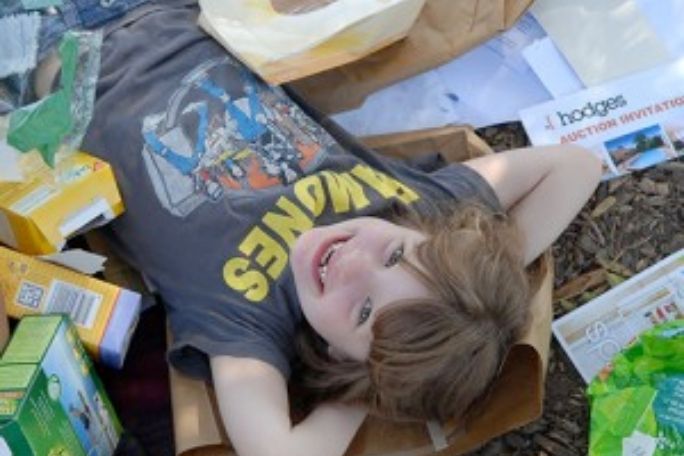Lesson summary
The Enviroweek Waste Warrior Action encourages students to explore their day-to-day wastage, the impacts of their waste, and how to make better choices with regards to waste. This resource is presented in the form of three separate but linked activities and has been differentiated into two activities, one for lower primary and one for upper primary.
Part 1 – Tune In: Students investigate their classroom’s waste management system
Part 2 – Act: Students plan and develop their own Waste Warrior Challenge.
Part 3 – Share: Students share their experiences and inspire others to take action.
Learning intentions:
Students will...
- understand the role and impact of excess waste on the environment.
- understand that different types of containers are used in classrooms to collect different types of waste.
- collect data about the school’s renewable and non-renewable waste management systems.
- rethink their waste management practices and take action to reduce wastage personally.
Lesson guides and printables
Lesson details
Curriculum mapping
Australian Curriculum content descriptions:
Foundation English:
- Listen to and respond orally to texts and to the communication of others in informal and structured classroom situations (ACELY1646)
- Use interaction skills including listening while others speak, using appropriate voice levels, articulation and body language, gestures and eye contact (ACELY1784)
Year 1 English:
- Engage in conversations and discussions, using active listening behaviours, showing interest, and contributing ideas, information and questions (ACELY1656)
- Use comprehension strategies to build literal and inferred meaning about key events, ideas and information in texts that they listen to, view and read by drawing on growing knowledge of context, text structures and language features (ACELY1660)
Year 1 Science:
- People use science in their daily lives, including when caring for their environment and living things (ACSHE022)
- Represent and communicate observations and ideas in a variety of ways (ACSIS029)
Year 2 English:
- Listen for specific purposes and information, including instructions, and extend students’ own and others’ ideas in discussions (ACELY1666)
- Use comprehension strategies to build literal and inferred meaning and begin to analyse texts by drawing on growing knowledge of context, language and visual features and print and multimodal text structures (ACELY1670)
Year 2 Science:
- People use science in their daily lives, including when caring for their environment and living things (ACSHE035)
- Use a range of methods to sort information, including drawings and provided tables (ACSIS040)
- Represent and communicate observations and ideas in a variety of ways such as oral and written language, drawing and role play (ACSIS042)
Year 3 Science:
- Science knowledge helps people to understand the effect of their actions (ACSHE051)
- Suggest ways to plan and conduct investigations to find answers to questions (ACSIS054)
- Represent and communicate ideas and findings in a variety of ways such as diagrams, physical representations and simple reports (ACSIS060)
Year 3 Mathematics:
- Measure, order and compare objects using familiar metric units of length, mass and capacity (ACMMG061)
Year 3 English:
- Plan, draft and publish imaginative, informative and persuasive texts demonstrating increasing control over text structures and language features and selecting print,and multimodal elements appropriate to the audience and purpose (ACELY1682)
- Plan and deliver short presentations, providing some key details in logical sequence (ACELY1677)
Year 4 Science:
- Science knowledge helps people to understand the effect of their actions (ACSHE062)
- Suggest ways to plan and conduct investigations to find answers to questions ACSIS065)
- Represent and communicate ideas and findings in a variety of ways such as diagrams, physical representations and simple reports (ACSIS071)
Year 4 Mathematics:
- Compare the areas of regular and irregular shapes by informal means (ACMMG087)
Year 4 English:
- Plan, rehearse and deliver presentations incorporating learned content and taking into account the particular purposes and audiences (ACELY1689)
Year 5 Science:
- Scientific knowledge is used to inform personal and community decisions (ACSHE217)
- With guidance, plan appropriate investigation methods to answer questions or solve problems (ACSIS086)
- Communicate ideas, explanations and processes in a variety of ways, including multi-modal texts (ACSIS093)
Year 5 Mathematics:
- Use a grid reference system to describe locations. Describe routes using landmarks and directional language (ACMMG113)
Year 5 English:
- Plan, rehearse and deliver presentations for defined audiences and purposes incorporating accurate and sequenced content and multimodal elements (ACELY1700)
Year 6 Science:
- Scientific knowledge is used to inform personal and community decisions (ACSHE220)
- With guidance, plan appropriate investigation methods to answer questions or solve problems (ACSIS103)
- Communicate ideas, explanations and processes in a variety of ways, including multi-modal texts (ACSIS110)
Year 6 Mathematics:
- Solve problems involving the comparison of lengths and areas using appropriate units (ACMMG137)
Year 6 English:
- Plan, rehearse and deliver presentations, selecting and sequencing appropriate content and multimodal elements for defined audiences and purposes, making appropriate choices for modality and emphasis (ACELY1710)
Syllabus outcomes: ST1-11LW, ST1-9ES, ST2-11LW, ST3-6PW, ST1-4WS, ST2-4WS, ST3-4WS, EN1-1A, EN1-4A, EN2-2A, EN2-6B, ENe-1A, MA2-10MG, MA2-11MG, MA2-12MG, MA2-9MG, MA2‑1WM, MA2‑2WM, MA2‑3WM, MA3-10MG, MA3-17MG, MA3-9MG, MA3‑1WM, MA3‑2WM, MA3‑3WM.
General capabilities: Numeracy, Critical and Creative thinking
Cross-curriculum priorities: Sustainability OI.2.
Additional info
This is an original Cool.org lesson. Facts and figures in these lessons may have changed since this lesson was published. We always endeavour to update our resources in a timely manner, but if you see an error or issue in our resources please get in touch with us.


Welcome back!
Don't have an account yet?
Log in with:
By signing up to Cool.org you consent and agree to Cool's privacy policy to
store, manage and process your personal information. To read more, please see
our privacy policy here(Opens in new tab).
Create your free Cool.org account.
Many of our resources are free, with an option to upgrade to Cool+ for premium content.
Already have an account?
Sign up with:
By signing up to Cool.org you consent and agree to Cool's privacy policy to
store, manage and process your personal information. To read more, please see
our privacy policy here(Opens in new tab).